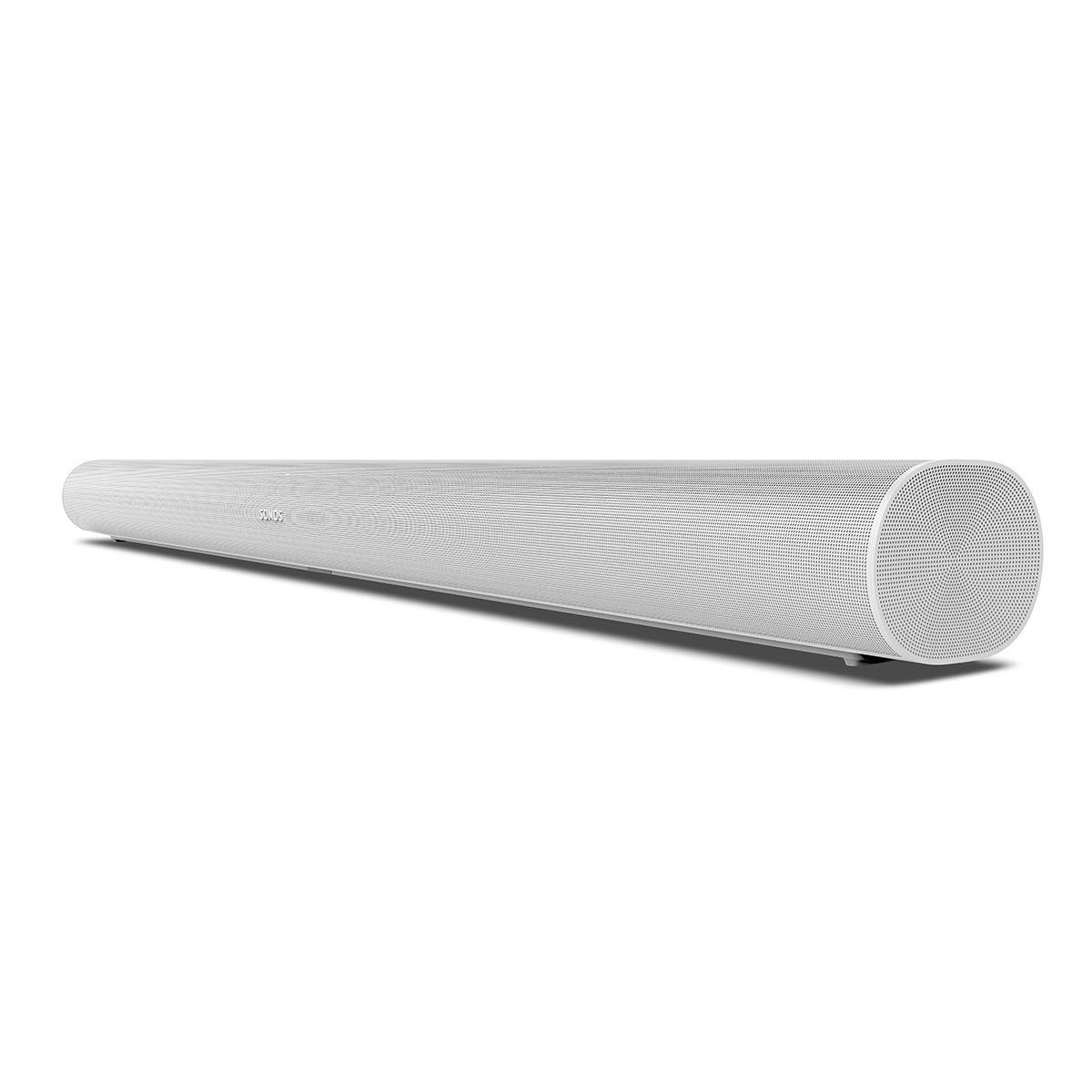
When it comes to upgrading your TV's sound, Sonos offers two distinctly different options: the premium Sonos Arc ($899) and the entry-level Sonos Ray ($279). Both aim to enhance your viewing experience, but they take notably different approaches. Let's dive into what makes each unique and help you decide which might be right for your setup.
Today's soundbars have evolved far beyond simple speaker replacements. They've become sophisticated audio systems that can simulate surround sound, process advanced audio formats, and even integrate with smart home systems. The key factors to consider include room size, TV compatibility, audio processing capabilities, and how you'll primarily use the system.
The Arc was released in 2020 as Sonos's flagship soundbar, bringing Dolby Atmos support and advanced processing to their lineup. It marked a significant step forward in home theater audio, particularly with its upward-firing speakers that create an immersive "dome" of sound.
The Ray arrived in 2022 as Sonos's most affordable soundbar, designed to deliver quality audio in a compact form factor. While it lacks some premium features, it brings Sonos's audio expertise to a more accessible price point.

The Arc delivers remarkable performance through its 11-driver array (which includes dedicated upward-firing speakers for Dolby Atmos). These drivers work together to create a convincing three-dimensional soundstage - imagine being able to hear a helicopter moving from left to right and seemingly above you. The Arc's processing power helps it separate dialogue from background effects, making movies more engaging and easier to follow.
The Ray takes a more focused approach with its four-driver system. While it can't create the same immersive experience, it excels at clarity and dialogue reproduction. Its custom-designed waveguides help project sound throughout the room, though without the height and depth of the Arc's presentation.
The Arc's larger size (45 inches) and more powerful amplification make it ideal for medium to large rooms. It needs some breathing room to properly reflect sound off walls and ceilings for its Atmos effects. You'll want at least an 8-foot ceiling height and some distance from viewing position for optimal performance.

The Ray's compact 22-inch width works well in smaller spaces and doesn't require specific room acoustics to sound its best. It's particularly suited to bedrooms, offices, or smaller living rooms where space is at a premium.
The Arc supports virtually every modern audio format, including:
This wide format support means it can handle anything from basic TV audio to the most advanced streaming and Blu-ray soundtracks.

The Ray focuses on core formats:
While more limited, these formats cover most everyday content from streaming services and TV broadcasts.
The Arc features HDMI eARC (enhanced Audio Return Channel), which allows for high-bandwidth audio transmission from your TV. This is crucial for getting the full quality of Dolby Atmos and other advanced formats. It also includes optical for older TVs, though you'll lose Atmos capability.
The Ray relies solely on optical audio connection, which is both a limitation and a simplification. While you won't get the most advanced audio formats, setup is straightforward and compatibility is nearly universal.

Both soundbars integrate with the Sonos ecosystem, allowing for multi-room audio and streaming from popular services. However, the Arc adds built-in voice assistants (Alexa and Google Assistant) and Apple AirPlay 2 support, making it more versatile for whole-home audio control.
The Arc truly shines with movies and TV shows, especially those with Dolby Atmos soundtracks. Action scenes become more engaging as sounds move around and above you. Even with standard content, its processing creates a wide, immersive soundstage that pulls you into the action.
The Ray focuses on clarity and dialogue enhancement. While it won't create the same immersive experience, it significantly improves upon TV speakers and makes dialogue easier to understand - particularly valuable for news and dialogue-heavy content.
Both soundbars handle music well, though differently. The Arc's additional drivers and processing power create a wider soundstage that works particularly well for orchestral and live recordings. The Ray produces a more focused sound that's excellent for vocal-centric music and smaller ensemble pieces.
Consider your priorities in this order:
The Arc justifies its premium price through superior audio performance, advanced features, and future-proof connectivity. It's an investment in your home theater that will likely satisfy for years to come.
The Ray delivers impressive performance for its price point, focusing on core audio quality rather than premium features. It's an excellent entry point into the Sonos ecosystem and a significant upgrade from TV speakers.
Both soundbars demonstrate Sonos's audio expertise, just at different scales and price points. Your choice ultimately depends on your specific needs, room setup, and budget rather than one being definitively "better" than the other.
| Sonos Arc | Sonos Ray |
|---|---|
| Price - Core consideration for value | |
| $899 MSRP (premium tier) | $279 MSRP (entry level) |
| Size - Impacts TV compatibility and room placement | |
| 45" wide × 3.4" high × 4.6" deep (13.78 lbs) | 22" wide × 2.8" high × 3.7" deep (4.3 lbs) |
| Audio Channels - Determines surround capabilities | |
| 5.0.2 with Dolby Atmos (upward-firing speakers) | 2.0 stereo (forward-firing only) |
| Speaker Configuration - Affects sound quality and volume | |
| 11 drivers (8 woofers, 3 tweeters) | 4 drivers (2 woofers, 2 tweeters) |
| Connectivity - Impacts audio format support | |
| HDMI eARC, Optical, Ethernet, WiFi | Optical only, WiFi |
| Audio Format Support - Determines content compatibility | |
| Dolby Atmos, TrueHD, Digital Plus, DTS | PCM Stereo, Dolby Digital |
| Smart Features - Adds convenience and functionality | |
| Voice assistants, AirPlay 2, Sonos app | Sonos app only |
| Room Size Recommendation - Critical for performance | |
| Medium to large rooms, 55"+ TVs | Small to medium rooms, up to 55" TVs |
| Additional Features - Enhances usability | |
| Speech enhancement, Night mode, TruePlay tuning | Speech enhancement, TruePlay tuning |
| Expandability - Future upgrade path | |
| Compatible with Sub, rear surrounds for 5.1.2 | Compatible with Sub, rear surrounds for 5.1 |
| Power Output - Impacts maximum volume | |
| High power (not specified by manufacturer) | Medium power (not specified by manufacturer) |
| Recommended Use Case - Primary consideration | |
| Home theater enthusiasts, premium audio seekers | Budget-conscious buyers, smaller spaces |
We've done our best to create useful and informative comparisons to help you decide what product to buy. Our research uses advanced automated methods to create this comparison and perfection is not possible - please contact us for corrections or questions. These are the sites we've researched in the creation of this article: whathifi.com - soundandvision.com - en.community.sonos.com - cnet.com - worldwidestereo.com - abt.com - creativeaudio.net - target.com - sonos.com - worldwidestereo.com - businessinsider.com - en.community.sonos.com - youtube.com - techradar.com - soundandvision.com - youtube.com - appleinsider.com - youtube.com - sonos.com - cnet.com - howtogeek.com - pcrichard.com - en.community.sonos.com - epicsystems.tech - en.community.sonos.com - cepro.com - videoandaudiocenter.com